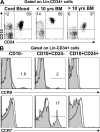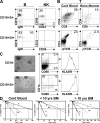A human postnatal lymphoid progenitor capable of circulating and seeding the thymus
- PMID: 18070935
- PMCID: PMC2150974
- DOI: 10.1084/jem.20071003
A human postnatal lymphoid progenitor capable of circulating and seeding the thymus
Abstract
Identification of a thymus-seeding progenitor originating from human bone marrow (BM) constitutes a key milestone in understanding the mechanisms of T cell development and provides new potential for correcting T cell deficiencies. We report the characterization of a novel lymphoid-restricted subset, which is part of the lineage-negative CD34(+)CD10(+) progenitor population and which is distinct from B cell-committed precursors (in view of the absence of CD24 expression). We demonstrate that these Lin(-)CD34(+)CD10(+)CD24(-) progenitors have a very low myeloid potential but can generate B, T, and natural killer lymphocytes and coexpress recombination activating gene 1, terminal deoxynucleotide transferase, PAX5, interleukin 7 receptor alpha, and CD3epsilon. These progenitors are present in the cord blood and in the BM but can also be found in the blood throughout life. Moreover, they belong to the most immature thymocyte population. Collectively, these findings unravel the existence of a postnatal lymphoid-polarized population that is capable of migrating from the BM to the thymus.
Figures




References
-
- Donskoy, E., and I. Goldschneider. 1992. Thymocytopoiesis is maintained by blood-borne precursors throughout postnatal life. A study in parabiotic mice. J. Immunol. 148:1604–1612. - PubMed
-
- Kondo, M., I.L. Weissman, and K. Akashi. 1997. Identification of clonogenic common lymphoid progenitors in mouse bone marrow. Cell. 91:661–672. - PubMed
-
- Kouro, T., K.L. Medina, K. Oritani, and P.W. Kincade. 2001. Characteristics of early murine B-lymphocyte precursors and their direct sensitivity to negative regulators. Blood. 97:2708–2715. - PubMed
-
- Bhandoola, A., and A. Sambandam. 2006. From stem cell to T cell: one route or many? Nat. Rev. Immunol. 6:117–126. - PubMed
Publication types
MeSH terms
Substances
LinkOut - more resources
Full Text Sources
Other Literature Sources
Medical

